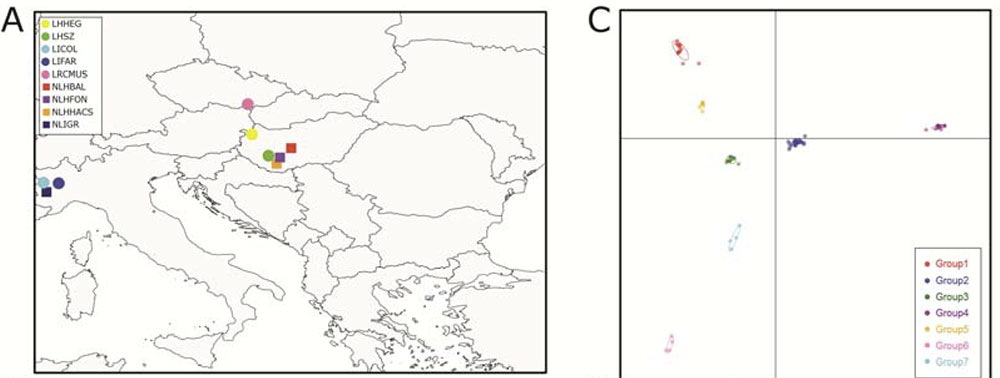New bioRxiv preprint A genetic perspective on Longobard-Era migrations, by Vai et al. (2018).
Interesting excerpts (emphasis mine):
In this study we sequenced complete mitochondrial genomes from nine early-medieval cemeteries located in the Czech Republic, Hungary and Italy, for a total of 87 individuals. In some of these cemeteries, a portion of the individuals are buried with cultural markers in these areas traditionally associated with the Longobard culture (hereby we refer to these cemeteries as LC), as opposed to burial communities in which no artifacts or rituals associated by archaeologists to Longobard culture have been found in any graves. These necropolises, hereby referred as NLC, may represent local communities or other Barbaric groups previously migrated to this region. This extended sampling strategy provides an excellent condition to investigate the degree of genetic affinity between coeval LC and NLC burials, and to shed light on early-medieval dynamics in Europe.

Social rank
There is also no clear geographical structure between samples in our dataset, with individuals from Italy, Hungary and Czech Republic clustering together. However, the first PC clearly separates a group of 12 LC individuals found at Szólád, Collegno and Mušov from a group composed by both LC and NLC individuals. The same pattern is also found when pairwise differences among individuals are plotted by multidimensional scaling (…)
The presence in this group of LC sequences belonging to macrohaplogroups I and W, commonly found at high frequencies in northern Europe (e.g. Finland 32), suggests (although certainly does not prove) the existence of a possible link between these 12 LC individuals and northern Europe. The peculiarity of this group is strengthened by archaeological information from the Szólád cemetery, where 8 of the 12 individuals in this group originated, indicating that all these samples were found buried with typical Longobard artifacts and grave assemblages. We do not find the same tight association for the 3 samples from Collegno, where the 3 graves are indeed devoid of evident Germanic cultural markers; however they are not placed in a separate and marginal location—as for the tombs without grave goods found in Szólád —but among graves with wooden chambers and weapons. It is worth noting that weapon burials were quite scarce in 5th century Pannonia and 6th century Italy (e.g. Goths never buried weapons), and an increase in weapon burials started in Italy only after the Longobard migration. In this light, the individuals buried in this manner may have been members of the same community as well, but belonging to the lowest social level. This social condition could explain the absence of artifacts and could be related to mixed marriages, whose offspring had an inferior social rank. Finally, this group also includes an individual from the Musov graveyard. This finding is particularly interesting in light of the fact that the Musov necropolis has been only tentatively associated with Longobard occupation (see Supplementary Text for details), based on the presence of but a few archaeological markers.
Female migration
We hence estimated that about 70% of the lineages found in Collegno actually derived from the Hungarian LC groups, in agreement with previous archaeological and historical hypotheses. This supports the idea that the spread of Longobards into Italy actually involved movements of fairly large numbers of people, who gave a substantial contribution to the gene pool of the resulting populations. This is even more remarkable thinking that, in many studied cases, military invasions are movements of males, and hence do not have consequences at the mtDNA level. Here, instead, we have evidence of changes in the composition of the mtDNA pool of an Italian population, supporting the view that immigration from Central Europe involved females as well as males.
Related
- Kortlandt: West Indo-Europeans along the Danube, Germanic and Balto-Slavic share a Corded Ware substrate
- Reproductive success among ancient Icelanders stratified by ancestry
- Genomic analysis of Germanic tribes from Bavaria show North-Central European ancestry
- Germanic tribes during the Barbarian migrations show mainly R1b, also I lineages
- mtDNA suggest original East Germanic population linked to Jutland Iron Age and Bell Beaker
- Admixture of Srubna and Huns in Hungarian conquerors
- The concept of “Outlier” in Human Ancestry (III): Late Neolithic samples from the Baltic region and origins of the Corded Ware culture
- Genetic prehistory of the Baltic Sea region and Y-DNA: Corded Ware and R1a-Z645, Bronze Age and N1c
- Bell Beaker/early Late Neolithic (NOT Corded Ware/Battle Axe) identified as forming the Pre-Germanic community in Scandinavia
- The Tollense Valley battlefield: the North European ‘Trojan war’ that hints to western Balto-Slavic origins